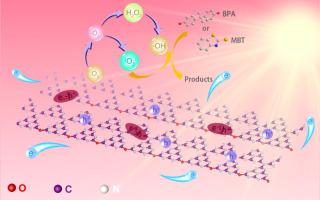Journal of Colloid and Interface Science ( IF 9.4 ) Pub Date : 2020-09-15 , DOI: 10.1016/j.jcis.2020.08.124 Liquan Jing , Minqiang He , Meng Xie , Yanhua Song , Wei Wei , Yuanguo Xu , Hui Xu , Huaming Li

|
Here, we successfully synthesized a brown carbon nitride (CY-C3N4) co-modified with oxygen bridge and porous defects via a universal acylation method. Excitingly, density functional theory (DFT) calculation shows that the introduction of oxygen bridges in the calcination polymerization process can adjust the electronic structure and energy band position of the new material. Further, the results of elemental analysis and X-ray photoemission spectroscopy test indicate that the oxygen bridge structure was successfully introduced into the skeleton of carbon nitride. The results show that 0.1CY-C3N4 can remove bisphenol A (BPA) and 2-mercaptobenzothiazole (MBT) with a removal rate of approximately 99% in 90 min and 20 min, respectively. Its degradation rate is 17.94 times and 3.85 times faster than that the original carbon nitride, respectively. Further, through HPLC-MS analysis, the intermediate products of the reaction process were analyzed in depth to propose a possible photocatalytic degradation route. Free radical capturing test and ESR spectroscopy indicate that the formative hydroxyl radical ( OH), superoxide radical (
OH), superoxide radical ( O2–), singlet oxygen (1O2) and hole (h+) all play a key role in the photodegradation. This study provides a new way to synthesize brown carbon nitrides with oxygen bridges and porous defects for environmental applications.
O2–), singlet oxygen (1O2) and hole (h+) all play a key role in the photodegradation. This study provides a new way to synthesize brown carbon nitrides with oxygen bridges and porous defects for environmental applications.
中文翻译:

实现电子调制对石墨氮化碳的协同作用,以实现双酚A和2-巯基苯并噻唑的高效光降解:机理,降解途径和密度泛函理论计算
在这里,我们通过通用的酰化方法成功地合成了与氧桥和多孔缺陷共修饰的棕色氮化碳(CY-C 3 N 4)。令人兴奋的是,密度泛函理论(DFT)计算表明,煅烧聚合过程中引入氧桥可以调节新材料的电子结构和能带位置。此外,元素分析和X射线光发射光谱测试的结果表明,氧桥结构成功地引入了氮化碳的骨架中。结果表明,0.1CY-C 3 N 4可以在90分钟和20分钟内分别去除双酚A(BPA)和2-巯基苯并噻唑(MBT),去除率约为99%。它的降解速度分别比原始氮化碳快17.94倍和3.85倍。此外,通过HPLC-MS分析,对反应过程的中间产物进行了深入分析,以提出可能的光催化降解途径。自由基捕获测试和ESR光谱表明,形成的羟基自由基( OH),超氧化物自由基(
OH),超氧化物自由基( O 2 –),单线态氧(1 O 2)和空穴(h +)都在光降解中起关键作用。这项研究提供了一种新的方法,可以合成具有氧桥和多孔缺陷的棕色碳氮化物,用于环境应用。
O 2 –),单线态氧(1 O 2)和空穴(h +)都在光降解中起关键作用。这项研究提供了一种新的方法,可以合成具有氧桥和多孔缺陷的棕色碳氮化物,用于环境应用。











































 京公网安备 11010802027423号
京公网安备 11010802027423号